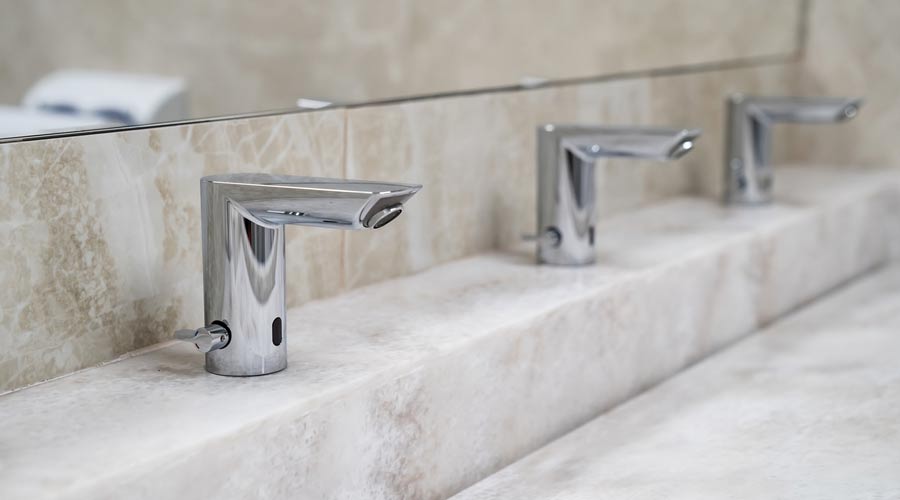New Weapons in War on Waste
A new generation of plumbing products plays a central role in facilities' efforts to curtail water costs
In 1992, the U.S. Congress passed the Energy Policy Act (EPAct), which addressed growing concerns about energy and water shortages by limiting the energy and water use of various products. The law included mandatory reductions in allowable water use for toilets, urinals, showerheads and certain faucets. Several studies have concluded that the resulting indoor water use per person has decreased by 30 percent.
Water conservation has re-emerged as a top priority in facilities nationwide. Drought and a growing population continue to put stress on water supplies. According to the U.S. Environmental Protection Agency (EPA), the U.S. population has grown 90 percent in the last 50 years, but public demand for water has risen 209 percent. A recent survey showed at least 36 states foresee local, regional or statewide water shortages by 2013.
These growing concerns are the basis for the renewal of the plumbing industry’s commitment to water efficiency, the impetus for new and enhanced plumbing technologies, and efforts to launch voluntary water-efficiency initiatives.
Toilets and Flushing Devices
Maintenance and engineering managers can choose from numerous high-efficiency toilet technologies that use 20 percent or less water per flush than required by EPAct. These products must meet the same flushing performance standards as their less-efficient counterparts.
There are two types of high-efficiency gravity flushing toilets — single- and dual-flush. A high-efficiency, gravity, single-flush toilet uses no more that 1.28 gallons of water per flush (gpf). Dual-flush toilets use 1.6 gpf for a full flush and 0.8-1.1 gpf for a short flush. Several studies conducted by water utilities have concluded the average flush volume for a dual-flush toilet is 20 percent or less than conventional 1.6 gpf toilets.
Toilets that feature pressure-assist technology and flushometer valves are also available in high-efficiency versions. Single- and dual-flush, high-efficiency flushometer valves have similar use levels as high-efficiency, gravity-flush toilets. Toilets equipped with high-efficiency pressure-assist technology are available at volumes of 1.28 gpf and 1.0 gpf.
Managers should note that reducing flush volumes in commercial applications could make those installations slightly more susceptible to problems. In some cases, high-efficiency toilets might not be able to overcome damaged, sagging or partially blocked drains in existing systems. Blockages also might occur if high-efficiency toilets discharge into long drain lines without supplemental flow from other fixtures to help transport waste effectively.
Urinals
Manufacturers have refined existing technologies and developed new ones that use 0.5 gpf or less. These products use 50-100 percent less water per flush than required by EPAct.
Like toilets, high-efficiency urinals might be more susceptible to problems where existing drain lines are damaged, sagging or partially blocked. But high-efficiency urinals can save thousands of gallons of water annually when properly maintained and installed according to manufacturer specifications.
Pre-rinse Spray Valves
Pre-rinse spray valves (PRSV) are used at dishwasher pre-rinse stations in commercial kitchens. In 2005, a revision to EPAct limited PRSV flow rates to 1.6 gallons per minute (gpm). As a result, PRSVs are available with flow rates of 1.1- 1.6 gpm.
Replacing a typical PRSV that uses up to 3 gpm with a high-efficiency unit can yield substantial water and energy savings. Food-industry studies estimate that each PRSV can save 60-180 gallons of hot water daily.
Faucets and Aerators
Manual and electronic faucets are available with faucet aerators and flow regulators that reduce flow rates and cycle volumes. For years, plumbing codes and faucets standards have mandated that public lavatories be limited to 0.5 gpm or 0.25 gallons per metering cycle.
Managers might find opportunities to conserve water by replacing older, non-compliant faucets and aerators with those that comply with current plumbing codes.
Managers should note that reducing faucet flow rates will increase wait times for hot-water use, which can affect actual water savings. Wait times also will vary due to pipe sizes, distance from the water heater and pipe insulation.
Shower Heads
Many higher-efficiency shower heads are available with flow rates of 2 gpm or less. These products use 20 percent or less water than required by EPAct and represent a significant opportunity to save water.
But when installing a higher-efficiency shower head that uses less than 2.5 gpm, it is important to specify and install the appropriate mix of products to minimize the risk of scalding and the occurrence of thermal shock.
Thermal shock is the rapid and uncomfortable change in water temperature — colder or hotter — causing an abrupt physical reaction that could lead to a serious injury. Rapid temperature changes result from the simultaneous use of other fixtures, such as a toilet, an appliance, or a washing machine, that demands a large quantity of water very quickly.
This situation creates a temporary pressure imbalance between the hot or cold water supplies, which in turn changes the ratio of hot and cold water and leads to a change in outlet temperature. If the temperature change is great enough, it can cause scalding.
Minimizing the risk of thermal shock and scalding is important in all applications. But precautions are especially important in existing showers with valves that have no features to provide protection from thermal shock or scalding.
Managers should ensure that all showers are equipped with an automatic compensating valve that complies with ASSE 1016 or ASME A112.18.1/CSA B125.1, and that are designed to provide thermal shock and scald protection at the flow rate at which the shower head will be used. Ideally, the manufacturer determines or verifies this design.
Widening Efforts
Organizations supporting environmental-assessment tools for commercial buildings are rushing to develop green commercial building guidelines as national standards. Indoor water-reduction strategies that include plumbing fixture and fitting use are part of these efforts. Each guideline requires indoor water usage to be reduced by 20 percent or more.
The U.S. Green Building Council, the Amer–ican Society of Heating, Refrigeration and Air-Conditioning Engineers, and the Illuminating Engineering Society of North America are developing a design standard for high-performance green buildings based on the Leadership in Energy and Environmental Design (LEED) rating system. At the same time, the Green Building Initiative is converting the Green Globes building-rating system into a national standard.
Finally, WaterSense, a recently established EPA voluntary program, has undertaken several water-efficiency initiatives. The program has developed a voluntary product specification and labeling scheme that differentiates water-efficient products in the marketplace.
It also has finalized a high-efficiency toilet specification requiring less than 1.3 gpf that managers can use to select products. And an internal investigation is underway into pursuing a future specification for shower heads.
David W. Viola is technical director for the Plumbing Manufacturers Institute. He serves as a codes and standards resource for members and holds positions on a number of industry committees.
Spotlight: PMI
The Plumbing Manufacturers Institute (PMI) is the national trade association of plumbing products manufacturers and suppliers. The institute functions as a sounding board for members, a source for industry and market information, and a coordinating and decision-making body for dealing with industry issues. Its member companies produce most of the nation’s plumbing products.
Over the years, membership in PMI has expanded to include manufacturers of all product lines, from fixtures and faucets, to flushing devices, shower heads and hand showers. The organization focuses its efforts on such issues as codes and standards harmonization, and water-conservation initiatives.
PMI has made the promotion of water efficiency a top priority. Its members are the industry leaders in producing water-efficient plumbing technologies that help building owners and operators meet their indoor water-reduction strategies.
PMI and its members have initiated efforts to bring together stakeholders from water utilities, the U.S. Department of Energy, the U.S. Environmental Protection Agency, the U.S. Green Buildings Council, the Green Buildings Institute, and ASHRAE to identify consistent approaches to plumbing-product water efficiency.
|
Related Topics:











